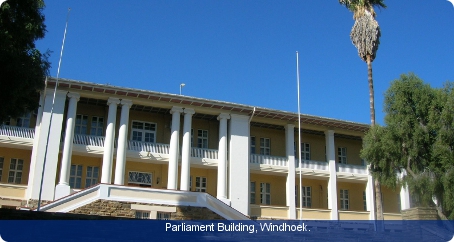Government
- Overview
- History

Namibia is a republic with an executive president as head of state and government. The president is elected by direct universal adult suffrage every five years, and must achieve more than 50% of the votes cast. He or she can only serve two successive terms.
The president appoints the prime minister, the cabinet and other important posts, but the National Assembly may revoke any appointment. The prime minister is the leader of government business in parliament.
The bicameral parliament is vested with legislative authority. The National Assembly has 78 members serving for a five-year term: 72 members elected by proportional representation and 6 members appointed by the president. The National Council has 26 members, two from each of the 13 regions; members are elected by regional councils and serve for a six-year term. The National Council has limited powers to review legislation passed by the National Assembly and can block bills.
The president may dissolve the National Assembly, and may also proclaim a state of national emergency and rule by decree, subject to the approval of the National Assembly. The National Assembly can remove the president by passing an impeachment motion with a two-thirds majority.
The 1990 constitution was one of the first to incorporate protection of the environment, and has entrenched clauses regarding fundamental human rights and freedoms. The constitution forbids the death sentence, detention without trial, and the practice and ideology of apartheid. Private property rights are guaranteed. Amendments to Namibia’s constitution can only be made by two-thirds majority in both houses.
Namibia is democratic, but it is dominated by one party, namely the South West Africa People’s Organization (SWAPO). Opposition parties are allowed but are widely considered to have little chance of gaining power.
The judicial structure parallels that of South Africa. Roman-Dutch law was declared the law of the territory and remains so today. The judicial system comprises the Supreme Court, presided over by a chief justice, the High Court, presided over by a judge president, and the lower and magistrates’ courts. The Supreme Court serves as a constitutional court and a final court of appeal. Appeals from the lower courts come before the High Court in the first instance. Judges are appointed by the president on the recommendation of the Judicial Service Commission.

The San (Bushmen), who are among the world’s oldest hunter-gatherers, have lived in this territory for over 11,000 years. The world’s oldest desert, the Namib, and the world’s largest known complete meteorite, the Hoba Meteorite, are located in Namibia.
In the late nineteenth century, the territory became a German protectorate named German South West Africa. South Africa occupied South West Africa during the First World War and in 1920 the League of Nations granted South Africa a mandate to govern the territory.
In 1946 South Africa refused to place South West Africa under UN trusteeship.
The first black nationalist movement, the South West Africa National Union (SWANU), was set up in 1959 with the support of the Herero Chiefs Council. In 1960 SWAPO was founded.
In October 1966, the UN terminated South Africa’s mandate and called for it to withdraw from the country, formally named Namibia in 1968. The International Court of Justice ruled in 1971 that South Africa’s administration was illegal.
After several decades of protracted negotiations, involving South Africa, the UN Security Council, Angola and Cuba, Namibia achieved independence in March 1990.
In the elections of 1989, ten political parties stood, including SWAPO, which gained 57% of the votes and 41 of 72 seats in the Constituent Assembly. In February 1990 Dr Sam Nujoma of SWAPO was elected by the Constituent Assembly to be the first president of an independent Namibia. Nujoma and SWAPO were returned to power in the December 1994 elections.
In late November 1998, parliament passed a constitutional amendment to allow Nujoma to serve more than two terms. The elections of 1999 produced a clear win for both Nujoma and SWAPO. Ben Ulenga of the recently formed Congress of Democrats (CoD) won 11% in the presidential poll, while Nujoma won almost 75%.
In 2001 Nujoma announced that he would not seek a fourth term of office. Hifikepunye Pohamba was chosen as the future presidential candidate for SWAPO.
In 2004 and 2009, Pohamba and SWAPO won landslide victories, in both the presidential and parliamentary elections.




